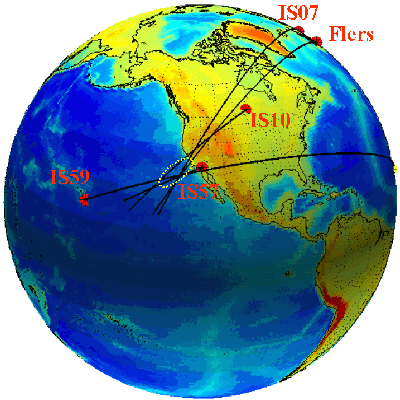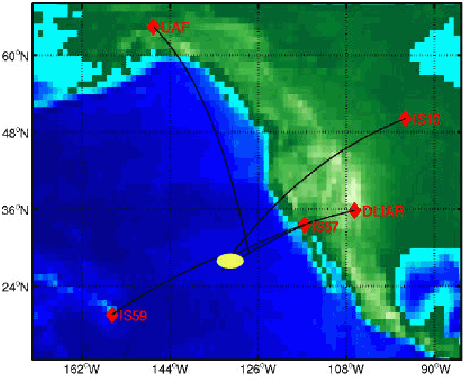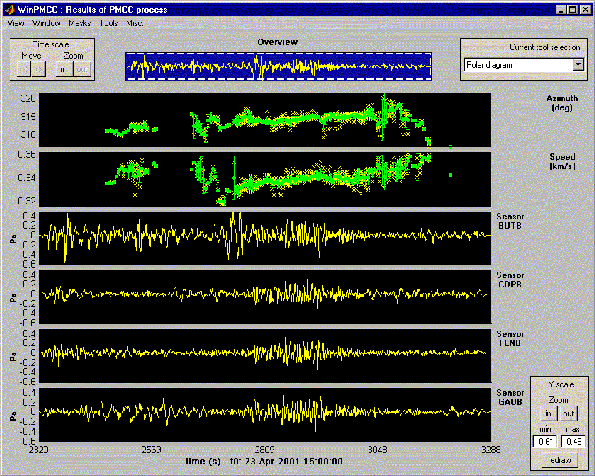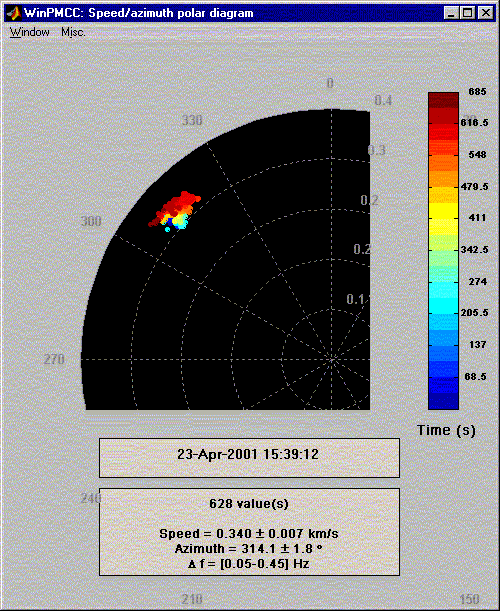 |
 |
 |
 |
 |
 |
 |
 |
 |
 |
Scientific files |
 |
 |
| |

 |
Meteor detected off California
on April 23, 2001 |
 Contents Contents
 The event The event
On April 23, 2001 at 06:12:35 am (UT), USA military satellites detected entry of a fireball through the atmosphere above the Pacific Ocean. The object was observed at an altitude of 28.5 km at point (29.90 N - 133.89 W). The total energy yielded by the event was equal to 4.6 x 1012 joules, equivalent to 1kT.
Infrasound signals were observed in four CTBT stations (IS10-Canada, IS26-Germany, IS57-Pinon Flat, IS59-Hawaii), in the Los Alamos experimental stations (DLIAR, SGAR) and in the UAF (Alaska) and Flers (France) prototype stations.
For the first time, the location of a meteor was determined by crossing azimuths and propagation times, based on detection data worldwide. In France, infrasound signals were detected at 3:45 pm (UT) after propagation of 10300 km. Signal central frequency was between 0.05 and 0.5 Hz. Horizontal speed measured at the station was close to the speed of sound. Apparent velocity of propagation from the source was equal to 291m/s (theoretical propagation times for thermospheric phases).


 |
Location based on azimuth intersection |

 |
Use of the interactive PMCC method for calculating the propagation parameters of the signal detected in Flers |

 |
Rephased signal detected in Flers |

 |
Horizontal speed/azimuth polar diagram for the signal observed in Flers |
 New York Times article New York Times article
May
29, 2001
Military Warning System Also Tracks Bomb-Size Meteors
By WILLIAM J. BROAD
In the early darkness of April 23, as Washington
was beginning to relax after the spy plane crisis
in China, alarm bells began to go off on the military
system that monitors the globe for nuclear blasts.
Orbiting satellites that keep watch for nuclear
attack had detected a blinding flash of light over
the Pacific several hundred miles southwest of Los
Angeles. On the ground, shock waves were strong
enough to register halfway around the world.
Tension reignited until the Pentagon could reassure
official Washington that the flash was not a nuclear
blast. It was a speeding meteoroid from outer space
that had crashed into the earth's atmosphere, where
it exploded in an intense fireball.
"There
was a big flurry of activity," recalled Dr.
Douglas O. ReVelle, a federal scientist who helps
run the military detectors. "Events like this
don't happen all the time."
Preliminary estimates, Dr. ReVelle said, are that
the cosmic intruder was the third largest since
the Pentagon began making global satellite observations
a quarter century ago. Its explosion in the atmosphere
had nearly the force of the atomic bomb dropped
on Hiroshima.
The episode shows how the system that warns of missile
attack and clandestine nuclear blasts is fast evolving
to detect bomb-size meteors as well. Now, it finds
them about once a month, on average. But Dr. ReVelle,
a scientist at the Los Alamos National Laboratory
in New Mexico, said in an interview that the developing
system was likely to find many more of the natural
blasts in the years ahead.
"The real
number is probably bigger," he said. "There's
no doubt about that. But we don't know how much
bigger."
Already, the system has shown that the planet is
being continually struck by large speeding rocks,
and that the rate of bombardment is higher than
previously thought. The blasts light the sky with
brilliant fireballs but people seldom see the blasts
because they usually occur over the sea or uninhabited
lands.
The rocky objects are anywhere from a few feet to
about 80 feet wide. They vanish in titanic explosions
high in the atmosphere, their enormous energy of
motion converted almost instantly into vast amounts
of heat and light.
The Air Force did not publicly disclose its imaging
of the recent blast until late May, more than a
month afterward. In a terse release on May 25, its
Technical Applications Center, at Patrick Air Force
Base in Florida, said the flash was "non- nuclear"
and consistent with past observed meteor explosions.
A Defense Department satellite, the Air Force said,
detected bright flashes over a period of more than
two seconds.
After that disclosure, Los Alamos got the military's
permission to reveal its own detection of the April
event. Its ground-based sensors are even more sensitive
than orbiting satellites to the repercussions of
meteor blasts. The ground-based sensors work like
sensitive ears to detect very low-frequency sound
waves, which radiate outward from an exploding rock
over hundreds and thousands of miles.
The sensors record sounds well below the range of
human hearing, including those from underground
nuclear tests as well as atmospheric blasts.
Dr. ReVelle said four arrays of the lab's sound
sensors had picked up the April blast. In addition,
he said, sound detectors in Los Angeles, Hawaii,
Alaska, Canada and Germany had picked up its shock
waves. Two sensors in South America made tentative
detections, he added.
"It was a big
event," he said. "There are people worrying
about impacts on the earth, and these things are
giving us a better understanding of the impact rate.
That's the real byproduct scientifically."
The speeding boulder was perhaps 12 feet wide, he
added.
An even more sensitive global ear is emerging as
the world's nations try to monitor the Comprehensive
Test Ban Treaty, a tentative accord that seeks to
end the exploding of nuclear arms and to police
compliance. When finished in the next year or so,
the global acoustic system is to consist of 60 arrays
that give complete global coverage, increasing the
odds that even more large meteor impacts will be
detected.
The disclosure of such intruders is seen as bolstering
the idea that the earth is periodically subjected
to strikes by even larger objects, including doomsday
rocks a few miles wide. Objects this size are predicted
to hit once every 10 million years or so, causing
mayhem and death on a planetary scale. |
|
|
| |
|
|
|